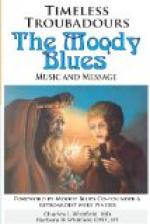E cant anetz per crozar a Saysso,
Ieu non avia cor—Dieus
m’o perdo—
Que passes mar, mas per vostre resso
Levey la crotz e pris confessio.
“And when you went to Soissons to take the cross, I did not intend—may God forgive me—to cross the sea, but to increase your fame I took the cross and made confession.” The count lost his life, as Villehardouin relates, in a skirmish with the Bulgarians in 1207. Raimbaut de Vaqueiras probably fell at the same time.
This is enough to show that troubadours who came to Italy could make the country a second home, and find as much occupation in love, war and politics as they had ever found in Southern France. Aimeric de Pegulhan, Gaucelm Faidit, Uc de Saint-Circ,[31] the author of some troubadour [100] biographies, were among the best known of those who visited Italy. The last named is known to have visited Pisa and another troubadour of minor importance, Guillem de la Tor, was in Florence. Thus the visits of the troubadours were by no means confined to the north.
It was, therefore, natural that Italians should imitate the troubadours whose art proved so successful at Italian courts and some thirty Italian troubadours are known to us. Count Manfred II. and Albert, the Marquis of Malaspina, engaged in tensos with Peire Vidal and Raimbaut de Vaqueiras respectively and are the first Italians known to have written in Provencal. Genoa produced a number of Italian troubadours of whom the best were Lanfranc Cigala and Bonifacio Calvo. The latter was a wanderer and spent some time in Castile at the court of Alfonso X. Lanfranc Cigala was a judge in his native town: from him survive a sirventes against Bonifacio III. of Montferrat who had abandoned the cause of Frederick II., crusade poems and a sirventes against the obscure style. The Venetian Bartolomeo Zorzi was a prisoner at Genoa from 1266 to 1273, having been captured by the Genoese. The troubadour of Genoa, Bonifacio Calvo, had written a vigorous invective against Venice, to which the captive troubadour composed an equally strong reply addressed [101] to Bonifacio Calvo; the latter sought him out and the two troubadours became friends. The most famous, however, of the Italian troubadours is certainly Sordello.
There is much uncertainty concerning the facts of Sordello’s life; he was born at Goito, near Mantua, and was of noble family. His name is not to be derived from sordidus, but from Surdus, a not uncommon patronymic in North Italy during the thirteenth century. Of his early years nothing is known: at some period of his youth he entered the court of Count Ricciardo di san Bonifazio, the lord of Verona, where he fell in love with his master’s wife, Cunizza da Romano (Dante, Par. ix. 32), and eloped with her. The details of this affair are entirely obscure; according to some commentators, it was the final outcome of a family feud, while others




